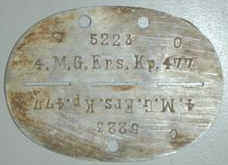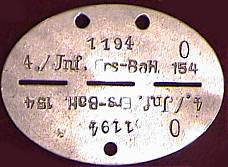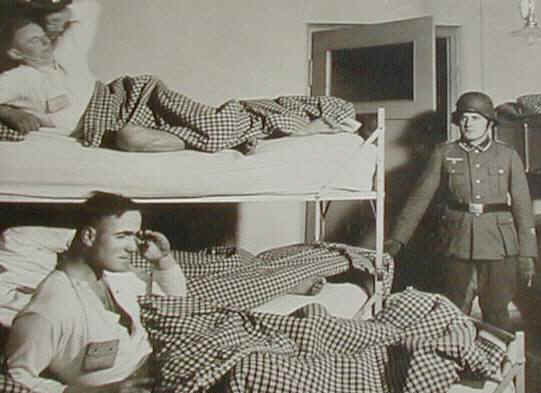Drawings
reproduced from Military Artifact Volume 2 Issue 3. These drawings are not to scale
with each other |
|
|
|
Identity Discs |
The Identity Disc (Erkennungsmarke) had a long history in the German Army; being first adopted during the 1870-71 war between Prussia and France. One gentleman with many sons serving in the Army noted that since dogs in the city of Berlin were tagged, it would be a good idea to do the same for soldiers. Wilhelm I did not like the idea of his men being compared to dogs, but he adopted the system anyway. The term "dog tags" may seem to some today to be uniquely American, but the Germans referred to them widely as Hundemarke by 1939 as well.
FIRST WORLD WAR
According to Clive Law's article "Use of the Identity Disc in the Imperial German Army" in Volume 2, Issue 3 of "Military Artifact", the forces of Imperial Germany utilized three types of identity disc during the Great War. All thee patterns were oval in shape, with two holes through which a cord was run and which allowed the disc to be worn around the soldier's neck. The tag was used to identify the soldier, especially in the event of his death.
The initial pattern measured 2 by 1-1/2 inches, and listed the man's regiment, company, and roster number. This is the only information that was contained on the disc - to ascertain a soldier's name, one would have to either check the soldier's paybook, or phaysically check the roster number on the tag with the actual company roster.
The second pattern, introduced in September of 1915, was made of zinc and was larger, measuring 2-3/4 by 2 inches. For the first time, a two part disc was used. When a man was enlisted into a depot unit, the upper portion of this disc was stamped with the soldier's name (first and last), last residence (for large towns this included the street and number), date of birth, depot unit, subunit (company, squadron or battery), and the soldier's roster number. Upon posting to a field unit, the lower part of the disc was stamped with the soldier's unit, subunit, and the roster number assigned to him by his new unit (officers were identified by a number in the Army List rather than individual unit rosters). If a man transferred to another field unit, the old markings were struck out and new stamps placed below.
In November 1916 the final pattern saw the disc divided in two by a perforated line, and markings on each half were identical. On the upper portion, the name, address and depot unit was stamped (as before) and on the back the field unit. If the soldier became a fatality, the lower half of the disc was snapped off and sent back to the depot unit in Germany, while the upper half was buried with the soldier's remains.
Officers were expected to supply their own discs.
Drawings
reproduced from Military Artifact Volume 2 Issue 3. These drawings are not to scale
with each other |
|
|
|
WEHRMACHT
The Wehrmacht also utilized Identity Discs, though the nature of the information changed significantly. Names were no longer stamped onto the tag, nor addresses. The soldier's depot unit and roster number were still stamped onto both the upper and lower halves of the disc, but field units were not, nor was the back of the tag stamped. Also, the four blood groups - A, B, AB, and O, were stamped onto identity discs identifying the soldier's blood type in the event he was wounded (the Germans did not differentiate between positive and negative blood types). If a soldier lost his tags, they were stamped with his current unit's name, otherwise, a soldier could go from his depot unit to a field unit, and be transferred to other field units without changing the information on his ID tag.
The tag was worn on a string or cord; a limited movement occurred after 1942 to introduce chains for armoured vehicle crews (since bodies that burned in the interior of a tank had the cords destroyed, and the tags would end up on the floor of the vehicle leaving no method of differentiating between the human remains in the tank).
Unit information was usually recorded in the following format: Company (identified by either an arabic numeral, or abbreviation such as St. (for Stamm- this was the reception company of a basic training unit), then a slash ("/"), with the name and number of the unit. Roman numerals, when used, generally indicated a battalion-sized unit.
| Abbr. | German Term | English Translation |
| Abt. | Abteilung | Unit, generally of battalion size |
| Ausb. | Ausbildungs | Training |
| Btl | Battaillon | Battalion |
| EK | Eisernes Kreuz | Iron Cross |
| Ers. | Ersatz | Replacement |
| Füs | Füsilier | A type of infantry unit |
| Gren. | Grenadier | The term for "infantry" that was used from 1942 on. |
| Kp | Kompanie | Company |
| Pi | Pionier | Engineers |
| Pz | Panzer | Tank |
| Pz Gren | Panzer Grenadier | Armoured or Motorized Infantry |
| St. or Stm. | Stamm | Reception |
| Regt. | Regiment | Regiment |
| u. | und | and |
| Werf | Werfer | literally "thrower", usually in reference to a Nebelwerfer or mortar unit |
For example, 4./Inf Ers-Btl 154 would be 4th company, Infantry Replacement Battalion number 154.
 |
 |
| Samples of Identification Discs; some tags had the stamps on both halves oriented the same way (below), the tags above have the stamps on the lower half upside down. | |
|
|
A common practice was to wear the tag in a leather pouch, which had two hold in the back to accept the cord, and two snaps on the front to allow access to the tag.

A staged photo used as a postcard, showing recruits being awakend. The
two sleepy recruits are wearing ID disc pouches (Erkennungsmarketaschen).